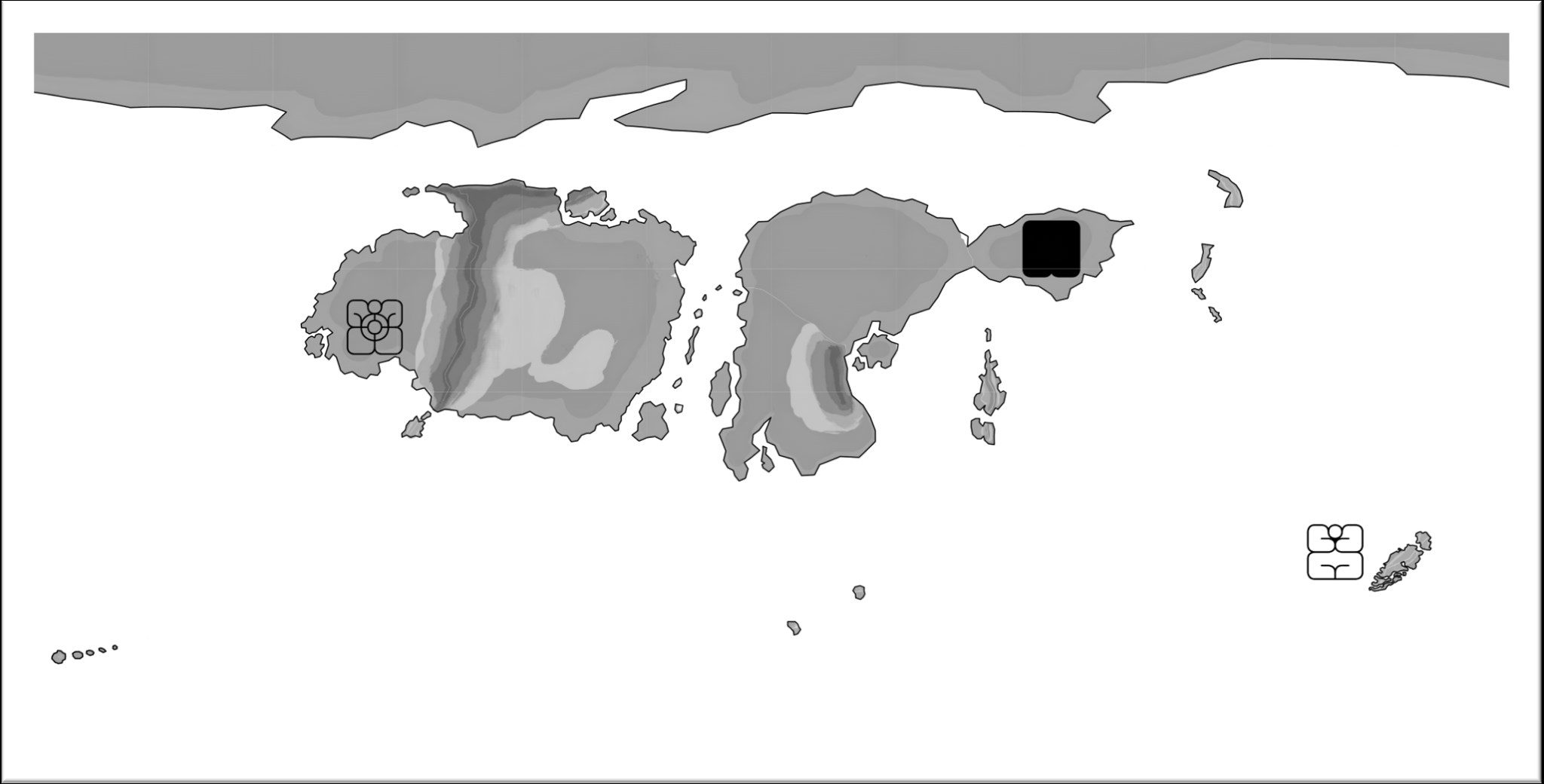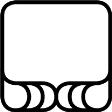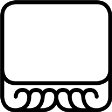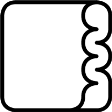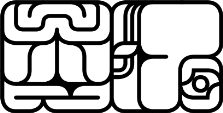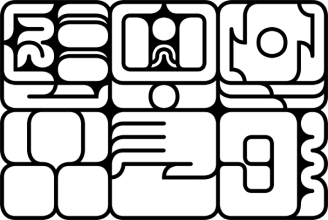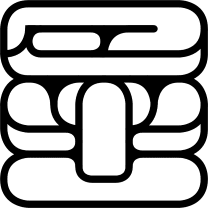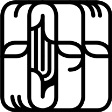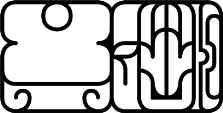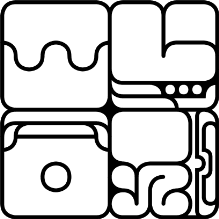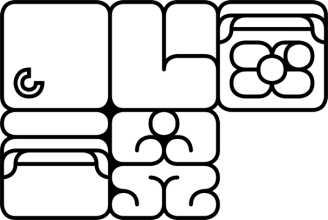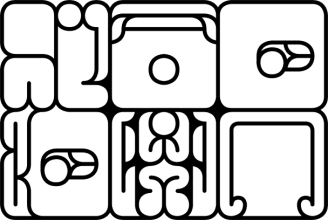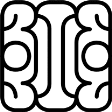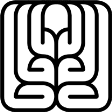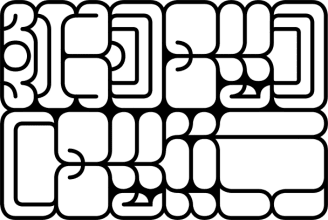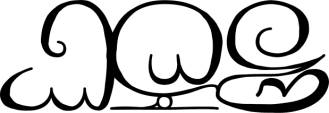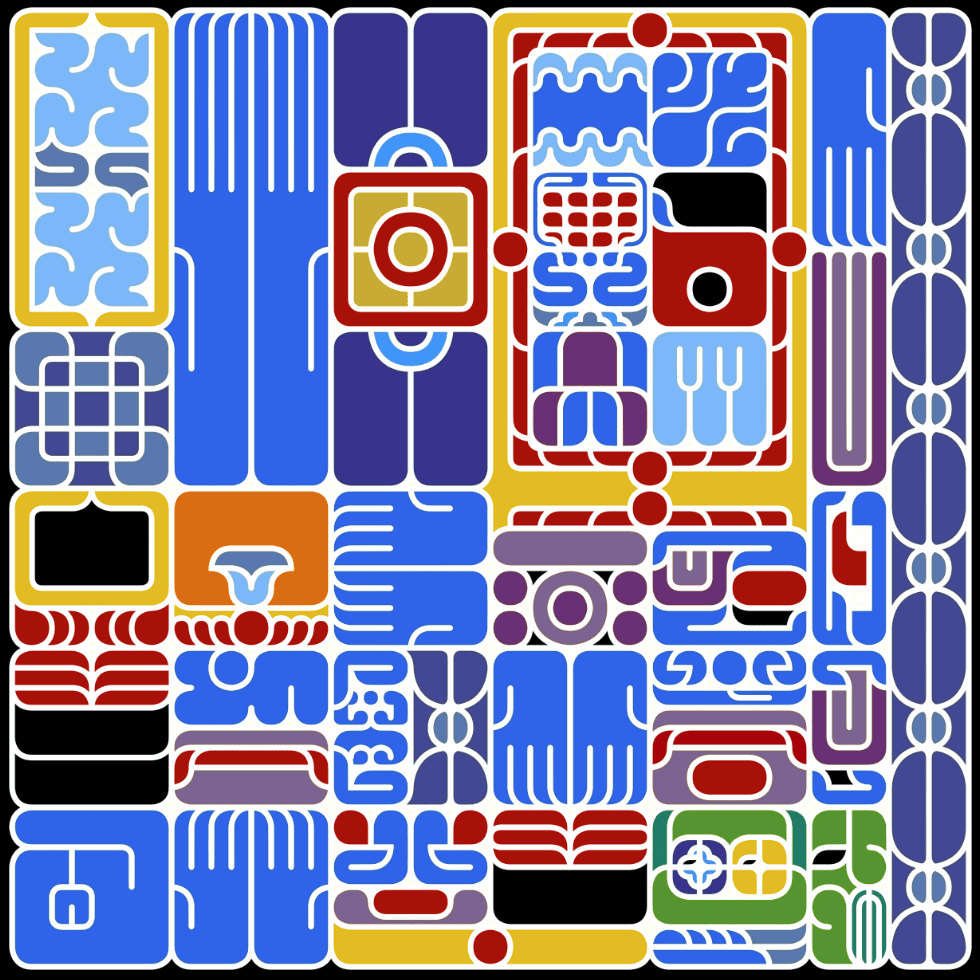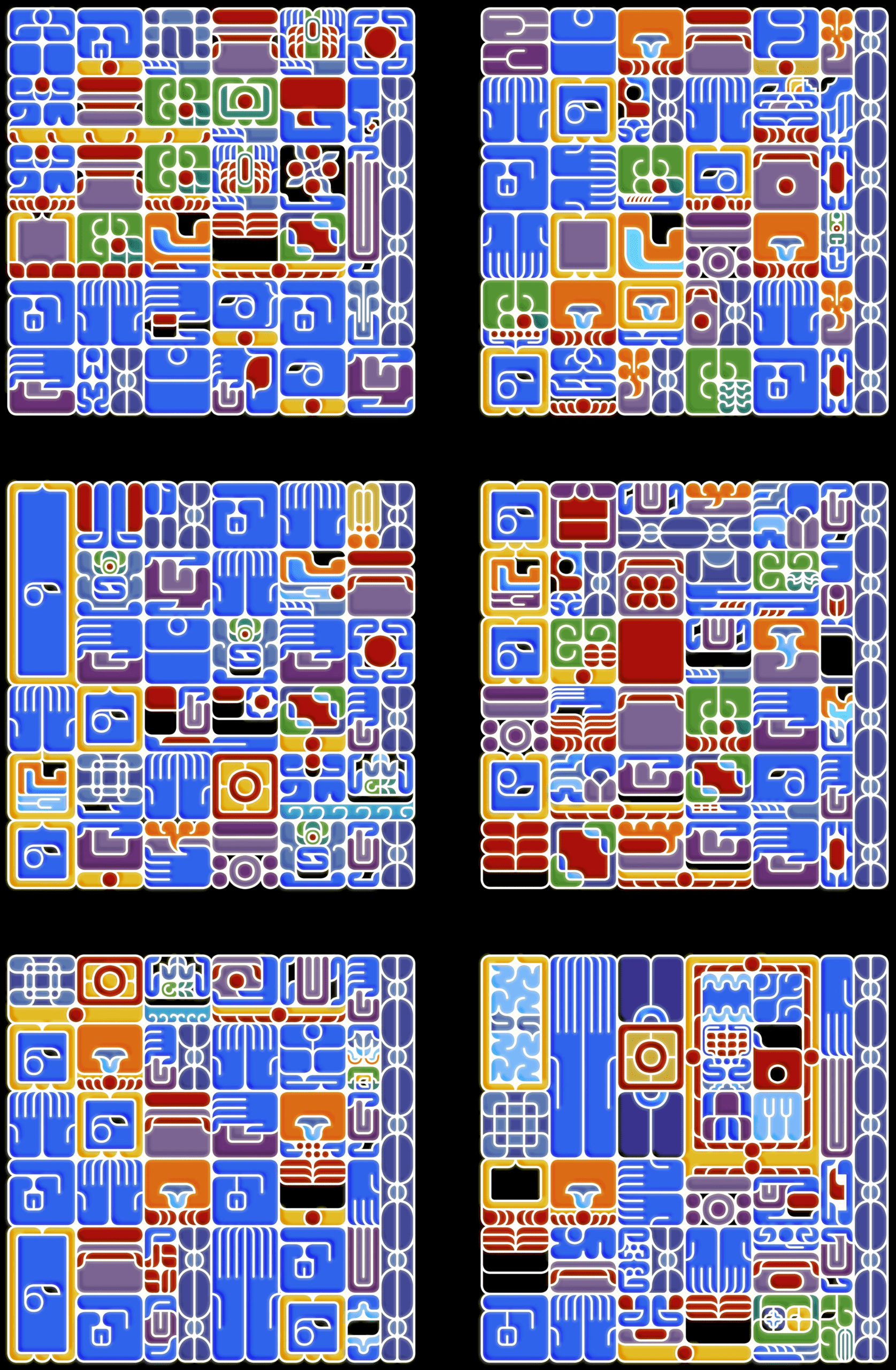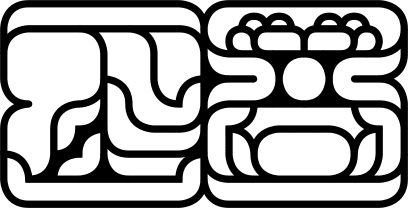Taadži Liguistics
Autore: Lauren Kuffler
Data della SM: 12-11-2022
Data FL: 03-01-2023
Numero FL: Florida-00008A-00
Citazione: Kuffler, Lauren. 2022. “Taadži Liguistics.” Florida-
00008A-00, Fiat Lingua,
Diritto d'autore: © 2022 Lauren Kuffler. Questo lavoro è concesso in licenza
sotto un'attribuzione Creative Commons-
Non commerciale, senza derivati 3.0 Licenza non trasportata.
http://creativecommons.org/licenses/by-nc-nd/3.0/
Fiat Lingua è prodotto e gestito dalla Language Creation Society (LCS). Per maggiori informazioni
riguardo alla LCS, visita http://www.conlang.org/
Taadži Linguistics
paraat lanjĩ
/paɾaːt lanjĩ/
“first words”
introduzione
The Tade Taadži language grew out of a broader worldbuilding
project begun in late 2020. I wanted to construct a language that
allowed me to play to my strengths, and from which I could work
on my weak points–I felt confident in my culture-building, and in
creating and evolving a written script that would be aesthetically
pleasing while also being feasible to write with authentic tools.
Tuttavia, With little formal linguistics training, creating a unique
grammar without an Indo-European bias is a difficult process for
Me. To get me started, I began with the phonemic inventory of
Proto-Uto-Aztecan and a few aesthetic goals for the writing sys-
tem, and slowly evolved from there. Tade Taadži is thus an ongo-
ing project, and a member of a language family that can provide
a fun space for me to learn and experiment.
Abstract
ngkko odorwà
/ŋ̩kːo odoɾwɐ/
“important teachings”
Tade Taadži is the representative conlang of an ongoing
worldbuilding project, focusing on a culture that arises from dis-
possessed peoples transported to an isolated archipelago. Questo
article will provide a brief historical context for the language,
describe its grammar and its logo-phonetic writing system. Nota-
ble features include an extensive system of ligatures in formal
texts, and a five-gender personal pronoun system. Any setting-
specific terms provided in the document can be assumed to be
those used by the Taadži culture, rather than local endonyms.
Fig. 1. An atlas of the planet Karawãhe, labeled in Lanje Taadži glyphs. The glyph representing the Naasengo species is redacted, In
accordance with Taadži cultural taboos. The remaining glyphs represent the homeland of the ancestral cultures of the Taadži
(Sinistra), and the Taadži themselves (right).
2
Radžuoğğu
/ɾad͡ʒuoɣːu/
Storia
Tade Taadži originates on an Earth-like plan-
et with near-zero axial tilt. This creates more extreme tempera-
ture gradients, and stronger mid-ocean currents. To simplify the
conlang creation process, this planet features two major human-
oid species, eventually referred to as the Naasengo and the
Taadži.
Geographic isolation kept these species largely
separated from each other. (Fig. 1) The smaller,
gregarious Naasengo that occupied the larger territory gave rise
to the imperialist ʻAgãłè culture, which colonized large portions
of the main continents. After learning of a navigable
passage through the treacherous waters near the
western mountain range, they came in contact with the
ancestors of the Taadži culture.
This species was larger (avg 2.3-2.4m), and evolutionary pres-
sures to adapt to local parasites and strong sunlight left them
senza peli, thicker-skinned and possessing dark sclera and a
distinctive green color to their blood, due to high levels of
circulating biliverdin. While their thick skin provided them better
protection from both biting insectoids and sunburn, it left them
less capable of sweating to achieve evaporative cooling.
Decorating the body with mud or other body pigments was a
common strategy to reduce sun exposure.
Local trade and exploration had resulted in some limited contact
between proto-Taadži and southwestern Naasengo cultures, Ma
their existence had been previously unconfirmed by the ʻAgãłè.
While seemingly primitive to the ʻAgãłè due to their relative lack
of metalworking technology, these proto-Taadži peoples were a
mix of settled and nomadic cultures, many of whom had
well-developed literary traditions, monumental ritual sites and/
or well-established population centers, and some possessed a
far more advanced understanding of medical theory and tech-
nique. Many worshiped celestial bodies as their mythic
ancestors, leading to their eventual name:
Taadžipanu, or Children of the Sun and Moon.
While initially welcoming to the newcomers and establishing
commercio, the Taadži cultures eventually began to push back against
colonial projects within their homeland, and the kidnapping of
their people. The ʻAgãłè responded aggressively, with captured
Taadži transported in slave ships to an isolated colonial project
on a mid-oceanic archipelago.
Enslaved Taadži were not permitted to write and deliberately
divided into groups that limited same-culture contact. Questi
measures were intended to decrease their capability to organize
and rebel, leading to the creation of a pidgin and the loss of
writing technology.
Nonostante questo, the Taadži mounted an increasingly organized
series of slave revolts, contributing to the failure of the colonial
venture. Di conseguenza, the ʻAgãłè left the archipelago, leaving the
Taadži behind on the most isolated land mass on the planet.
While poorly adapted to their new environment, enough Taadži
survived to form a genetically viable population. This archipelago
remained isolated from the outside world for centuries to come,
outlasting the ʻAgãłè and possibly the entire Nassengo species.
Fig. 2 A map of the Taadži archipelago, or Taadžipanuhe. This project focuses on Tade Taadži, a linguistically conservative eastern
language spoken near the original colony (centered at star).
2
3
While the creole language of the Taadži peoples developed into
multiple branches as they slowly radiated to new foraging and
fishing grounds, this project currently focuses on one relatively
early dialect, Tade Taadži.
proximity.
The sibilant affricates ts/dž can’t follow plosives or sibilants
except t/d, ŋ can’t follow plosives, sibilants or rhotics, rhotics
can’t follow labial(ized) or glottal plosives.
lanjy papaaxẽ
/lanjɨ papaːxẽ/
“word dance”
Linguistics
Tade Taadži has a Nominative-Accusative alignment and an SOV
word order, with OVS subordinate clauses. The language is
head-final, with adjectives and descriptive clauses preceding the
noun or verb they modify, and postpositions are used. The pos-
essee is marked rather than the possessor. The language has
recently transitioned from analytic to mostly synthetic, con
noun-adjective agreement in case and plurality. Verbs feature
optional person-marking.
Length and
Phonotactics
ybamxũ kaanjã
/ɨbamxũ kaːnjã/
“wall (Di) sound”
Tade Taadži features contrasting vowel and consonant length.
Fino a poco tempo fa, Tade Taadži had no distinction between voiced
and unvoiced consonants. A weak distinction is evolving, but in
most cases voicing is non-contrastive. The basic syllable
structure of Tade Taadži is as follows:
(C){V,S}(C), with S = m, N, ŋ, j, ɫ, and w.
Geminate consonants, long vowels, and nasal vowels are
contrastive versus their basic counterparts. Plosives must be
spaced by a central vowel if compounding would place them in
Stress
Stress defaults to the first
non-affix syllable.
kağ kaanjã
/kaɣ kaːnjã/
“strike sound”
If there are one or more long vowels in a non-final position, IL
stress falls on the first long vowel. If there are geminate
consonants, the non-ultimate syllable following the long
consonant or incorporating it as its onset takes the stress, salvo che
it is an affricate or fricative.
Romanization
lanjkaanjmi syturhe
/lanjɨkaːnjmi sɨtuɾhe/
“written sound from
foreign place”
The romanization used in this text is focused on aiding the
reader in acquiring consistent pronunciation of Tade Taadži, e
follows IPA transcription fairly closely (Table 1). It is thus more
descriptive than the minimal pairs that native Taadži speakers
would identify, including distinctions between voiced and
unvoiced consonants, and distinctions between vowel sounds
that are found in specific phonotactic contexts. Length or
gemination indicated in the romanization with double letters. In
digraphs, the sonorant is doubled. Così, /ŋː/ is rendered as nng,
/t͡s/ is rendered as tss, and /d͡ʒ:/ is rendered as džž.
Table 1. Phonology and romanization of Tade Taadži. Romanization is listed (in parentheses) when it differs from IPA.
Labial
Coronal
Dorsal
Laryngeal
Alveolar
Palatal
Velar
Glottal
Front Central Back
Place → Man-
ner ↓
Nasal
Plosive
Sibilant
affricate
Fricative
m
P, b
N
t, d
t͡s, d͡ʒ~d͡z (dž)
ɲ (ñ)*
ŋ (ng)
k, g
ʔ (ʻ)
s, z.z
X, ɣ (ğ)
h
Approximant
w~v
l, ɫ (ł)
j
Rhotic
ɾ̥~ɾ~r (r)
*a marginal phoneme only found in a few words.
ɨ, ɵ
(si, è)
tu
ũ
o
õ
Vicino
Vicino-
mid
Open
io
ĩ
e
ẽ
UN, ɐ
(UN, à)
ã
3
4
Nouns and Adjectives
lanjy pavã
/lanjɨ pavã/
“word (Di) thing”
There is only a very weak distinction between nouns and
adjectives, which are treated the same grammatically. Sono
better thought of as concrete and abstract or descriptive nouns.
Tade Taadži is early in the process of transitioning from an
analytic to a synthetic language, and thus features five fairly
regular declension patterns. Noun and Adjective cases are
Nominative, Accusative, Possessed, Allative, Instrumental, e
Vocative. Adjectives agree with the case of the noun they
modificare. Adjectives or modifying nouns come before the primary
sostantivo.
Nominative marks the actor for both transitive
and intransitive verbs, and modifiers of verbs. Esso
is unmarked in the singular form.
Ozà huumà. /ozɐ huːmɐ/
reptomammal.PL.NOM sleep.STAT
“Animals sleep.”
Accusative marks the patient of transitive verbs.
Naiddahe saangwus haapu.
/naidːahe saːŋwus haːpu/
Naiddahe.NOM shy.prawn.ACC
see.NEARPAST
“Naiddahe saw a darting prawn.”
Possessed marks an object possessed by
qualcosa (his book, the person’s word), an
origin (people from the islands), and apposition (my sister, UN
healer). Possessed nouns come before the noun they modify,
and can be compound-forming, though the case marker may be
dropped depending on sound similarity. The word order of
(concrete) noun adjuncts also follows this pattern (ex. “face
mask” would be literally rendered “mask (del) face”).
Uzumi papã kamitsigwis kii.
/uzumi papã kamit͡sigwis kiː/
body.paint.POS moon.NOM
crater.PL.ACC exist.STAT
“The dark markings on the face of the moon are craters.”
Allative marks motion toward (I went to the
casa), direzione (I went north), and also marks
indirect objects of most verbs (I gave the stone
to her). The Allative comes after the
Nominative and Accusative.
Aratmàpà jazdu idda aannagu. /
aɾatmɐpɐ jazdu idːa aːnːagu/
Aɾatmàpà.NOM sea.ALL go.INFV
want.PRES
“Aratmàpà wants to go to the sea.”
Instrumental acts as the agent of passive voice
construction (I was hit by the stick), and to
indicate location (I work in the field), Ore (I work today),
participation in an action (she benefited from her mother’s love),
substance of composition (a wheel of cheese), source (a portion
of food), and comitative statements (I went in the company of
the fisherman). Instrumental nouns follow the noun they modify.
Laranwà kushyngyr swtsddur sydurpy.
/laɾanwɐ kushɨŋɨɾ̥ sw̩ t͡sdːuɾ̥ sɨduɾpɨ/
tree.PL.NOM east.PL.INST wind.INST
curve.STAT
“Trees from the east are bowed because of the wind.”
Vocative identifies an addressee, and is the
default case in most dialects for referring to the
gods. Some dialects may use the vocative only as
a pejorative, while others are beginning to use the vocative as a
topic marker.
Xummmaa, nga ʻus tsã pavà pavapso?
/xumːaː ŋa ʔus t͡sã pavɐ pavapso?/
friend.VOC 2S.NOM ACC Q.INFML therefore
do.NEARPAST-that.ACC
“Oh friend, why did you do that?"
Table 2. Taadži declensions
Singolare
NOM ACC POS ALL
INST
VOC
1. -/t/d/ts/dž/
s/z/ʻ/w/h/(V)
2. -/y/i/e/(r)
3. -/N/Ṽ/(jV)
4. -/u/o/(r)
5. -a(r)
Standalone
–
–
–
–
–
–
-wus -di
-du
-ddur
-dà
-us
-e
-u
-yr
-uu
-ns
-us
-as
ʻus
-mi
-my
-mr
-maa
-i
-i
Esso
-u
-a
su
-ur
-ar
yr
-oo
-àà
àà
Plural
NOM ACC POS ALL
INST
VOC
1. -/t/d/ts/dž/
s/z/ʻ/w/h/(V)
-zà
-zat
-zabi -zà
-zur
-zàà
2. -/y/i/e/(r)
-Ṽ
-Ṽs
-ẽ
-(V)
-(V)ngyr -(V)nguu
3. -/N/Ṽ/(jV)
-wà
-was
-wi
-wy
-wur
-wàà
4. -/u/o/(r)
-wi
-wis
-wi
-wu
-wur
-woo
5. -a(r)
-agà
-agas -agi
-agà
-agar
-agàà
Standalone particles acting as case markers may be used for
emphasis, to separate different noun phrases in the same case,
and/or to mark the end of a subordinate clause. For the
nominative case, an appropriate pronoun may be used (see page
7). This is a remnant of the analytic grammar of the early Taadži
creole which has maintained useful grammatical functions.
Sot suwus sage hadžedžaazat joovũ mavarà yr jaddiigopu
xummr taat ʻus haapu.
/sot suwus sage
had͡ʒed͡ʒaːzat joːvũ
mavaɾɐ ɨɾ̥ jadːiːgopu
xum̩ ːɾ̥ taːt ʔus haːpu/
3S.NOM pot.ACC take.PRES shellfish.ACC.PL water cook.INF INST
bay.ALL friend.INST 3SM.NOM ACC see.PAST
She saw that he took the pot to the bay to boil shellfish with a
amico.
4
5
Verbs
paʻwanjy
/paʔwanjɨ/
“doing word”
Verbs have four tenses: Remote Past, Passato,
Presente, and Future. Tense is strictly absolute
(centered on the “now”) unless directly quoting someone.
Table 3. Taadži tenses. The 3rd and 4th conjugations are
differentiated by etymological roots of a given verb.
Verb Stem Remote Past Present Future Imperative
-a,ã,io,ĩ,X,P,t
-Vdžu
-Vpu
-Vgu
-Vzi
-Vdžã
-e,o
-u
-u(s)
-Vdže
-Vpe
-Vge
-Vzi
-Vdžã
-adže
-ape
-age
-azi
-adžã
-udžas
-upas -ugas
-uzis
-udžã
Remote Past tense is usually used to refer to events
that occurred more than one day ago. It can also
function as a discontinuous past tense, where the event
has experienced a change. It may also be used for
recent events that the speaker was present for but does not
clearly remember.
Tsudu tyjddadžu. /t͡sudu tɨjdːad͡ʒu/
beach.ALL 3SF.go-RPAST
“She went to the beach (before today/but isn’t there anymore)"
Tsudu jinmr tyjddadžu.
/t͡sudu jinm̩ ɾ̥ tɨjdːad͡ʒu/
beach.ALL today.INST 3SF.go-RPAST
“I think she went to the beach today”
Past tense or Simple Past tense refers to events within
the past day, or when the speaker wants to emphasize
the clarity of their memory.
Tsudu jinmr tyjddapu.
/t͡sudu jinm̩ ɾ̥ tijdːapu/
beach.ALL today.INST 3SF.go-PAST
“She went to the beach today”
Present and Future tenses can be used for
statements that would refer to the continuous
or perfective aspect, but not for gnomic or
attributive (vedi sotto).
Tsudu tyjddagu. /t͡sudu tijdːagu/
beach.ALL 3SF.go-PRES
“She’s going to the beach”
The Infinitive is the uninflected form of the verb with its stem
included, and can be used as the Gnomic aspect, describing
general truths rather than specific events. The infinitive
is often used in multi-verb constructs, including some
with grammatical functions (Table 4).
Tsudu tyjdda. /t͡sudu tɨjdːa/
beach.ALL 3SF.go
“Everyone knows that she goes to the beach.”
Attributive verbs can be created by removing the verb
stelo. This is not represented in the writing system.
They are treated as an adjective, and precede any word
they modify.
Kavax sugarmavat tetaadžus kavaxege.
/kavax sugaɾmavat tetaːd͡ʒus kavaxege/
burn.ATTR fire-pit.NOM child.ACC
warm-PRES
“The burning fire pit warms the child.”
Perfective aspect is created by taking the infinitive
verb and adding the verb kus (“to come”). Questo è un
serial verb construction with kus taking most
inflection, except for nominative person marking (see pg. 6).
Pavà anngar tsigur, xitssejanns kav haadi
nanmy aʻukiju kusadže.
/pavɐ aŋːaɾ̥ t͡siguɾ̥ xit͡sːejanːs kav haːdi
nanmɨ aʔukiju kusap/
make.INFV dry.clay.INST rock.INST,
wet-clay.ACC watch.ATTR eye.POS sun.ALL
1P-set.down PERF.RPAST
“We laid the clay in the sun to make bricks.”
Passive verbs are formed in a similar manner, utilizzando
the auxiliary verb su (“to take”). The subject of the
verb is placed in the instrumental case, e il
object remains in the accusative.
Jaadns ʻogmr sukype sadže.
/jaːdn̩s ʔogm̩ ɾ̥ sukɨpe sad͡ʒe/
storm.ACC delicate.plant.INST break PASS.RPAST
The delicate plant was broken by the storm.
Hypothetical mood is created in the same way,
with the auxiliary verb kaanja (“to hear”).
Uvaswovus jinmr irtyr rat su kaanjapu.
/uvaswovus jinmɾ̥ iɾtɨɾ̥ rat su kaːnjapu/
earthquake.ACC bridge.INST today.INST cut
PASS HYP.PAST
“The bridge could have been cut in today’s
earthquake.”
The hypothetical mood can also be used to construct if/then
statements. The “then” clause is the primary clause, and takes
the hypothetical mood. The “if” clause is dependent. Quando
describing a hypothetical action, the clause is marked with the
instrumental case. When describing a precondition beyond one’s
power to affect, the allative case is used.
Aʻujoovũnavarazisai yr kmg tsaʻiwus ajihopà
kaanjazi.
/aʔujoːvũnavaɾazisai ɨɾ̥ km̩ g t͡saʔiwus ajihopɐ
kaːnjazi/
1P-boil-FUT-this INST eat.ATTR safe.ACC
this.be.at.INFV HYP.FUT
“If we boil this, then it will be safe to eat.”
Axohuumazi kushyxanã up laramiigopu tyjazzaddà kaanjazi.
/axohuːmɐzi kushɨxanã up laɾamiːgopu tɨjazːadːa kaːnjazi/
that.calm.sea-FUT tomorrow.NOM ALL
reef.ALL 3SF.boat.travel HYP.FUT
“If tomorrow has calm seas, then she’ll
paddle out to the reef.”
5
6
Imperative mood is formed either through the verb
tsã (“to require” or “must”), or through its
grammaticized suffix form –Vdžã.
Laranwadu ngakahha tsagu!
/laɾanwadu ŋakahːa t͡sagu/
forest.ALL 2S.run must-PRES
“You must run to the forest!"
Tsawus kapu pavadžã! /t͡sawus kapu pavad͡ʒã/
health.ACC 2S.ALL make-IMP
“Be healthy!" (or less literally, a formal “Hello!")
Verbs can optionally be marked for person in the nominative
and accusative case in most dialects of the language, with some
additionally marking the instrumental case. This is not required,
nor are pronouns required if sufficient context is established. In
multi-verb constructions, the nominative marking is applied to
the first verb, and the accusative and/or instrumental marking is
applied to the final verb.
Nota: If a vowel is phonotactically required to attach a person
marker to a verb, but none is given in the table, then an echo
vowel is used. If the preceding syllable has a consonantal
nucleus, it is either echoed or /ɨ/ is used.
Axoggudarà
/axogːudaɾɐ/
3P.FAR.NOM-teach-1S.ACC-3P.NEAR.INST
“They teach me about that/them.”
Serial verb construction is possible in Tade Taadži. The initial
verb in a serial construct takes nominative person marking. Tutto
non-final verbs and are kept in the infinitive. The first verb takes
nominative marking, and the final verb takes accusative,
instrumental, and/or tense marking.
Kare Hyb Patsaahi pnʻowaranwas rarizi
mavarawapasai.
/kare hɨb pat͡saːhi pn̩ʔowaɾanwas rarizi
mavarawapasai/
All jump moon.fish.NOM tuber.PL.ACC 3S.AND
-gather cook.PAST-3PNEAR
Kare Hyb Patsaahi gathered the tubers and cooked them.
Table 4. Other verb conjugations in Tade Taadži.
Mood/Form/
Voice/etc.
Conjugation/Inflected
Auxiliary Verb
Senso
V + stem
Infinitive
Attributive V – stelo
To X
the X-ing /Noun/
Perfective
INFV + kus (“venire”) X-ed; Finish X-ing
Passive
Hypothetical INFV + kaanja (“sentire”) would/could/might X
INFV + su (“prendere”)
is/was/will be Xed
Table 5. Person marking on Tade Taadži
Verb Marking
NOM
ACC
INST
1S
2S
t(o)-
-t, -dà
-(o)t
ng(UN)-
-k(à)
-kat, -gat
3S Fem.
3S Lean Fem.
ty-
pi-
3S Androgynous
ra-
3S Lean Masc.
3S Masc.
ki-
ta-
-s, -ze
-t,-di
-r(à), -à
-k(tu)
-t, -dà
-(z.z)A
-(b)Esso
-(r)A
-(g)Esso
-yt, -dyt
Plural
NOM
ACC
INST
1P
2P
3P Near
3P Far
aʻu-
aka-
aj(io)-
ax(o)-
-(io)t
-sà
-sai
-so
-rat
-rage
-rà
-rage
6
7
Pronouns
Tade Taadži has first, secondo,
and third person pronouns,
which take declension. The first and second person pronouns
have singular and plural forms.
Lanjy mĩ
/lanjɨ mĩ/
“word (Di) all”
Their written glyphs function both independently and as radicals
for verb person-marking. (For more about the writing system,
see pg. 11)
Third person pronouns are split into five grammatical genders,
each matching a social role within Taadži culture. These roles are
loosely mapped onto a continuum of most to least feminine, Ma
the actual realization of these roles is inconsistent across
cultures, and has minimal correlation to sex or reproductive role.
Nearness counts as 2 steps towards masculine/feminine for
female/male speakers, 1 step in either direction for all others.
Familial nearness is dependent on the culture and context.
There is a weak remnant of a grammatical gender system in the
endings of nouns and adjectives, which is mostly used to
determine the use of near/far person markers on verbs in
informal speech. Adjectives no longer agree with the gender of
their noun, but poetic or deliberately archaic speech may use
personal pronouns in agreement with a noun’s gender.
Sot kapyğmi harawus paduu tymavadžusai.
/sot kapɨɣm̩ i haɾawus paduː tɨmavad͡ʒusai/
3F.NOM village.POS ancestor.ACC 1P.ALL
3F.NOM.tell.story.RPAST-3P.NEAR.ACC
“She tells us a story about the ancestor of her
village.”
Taat harazat odorõ taanngare kiiguso.
/taːt haɾazat odoɾõ taːŋːaɾe kiːguso/
3M.NOM ancestor.PL.ACC thought
3M.NOM.crush able.to-PRES-3P.FAR.ACC
“He isn’t making any sense”,
lit. “He could confuse the ancestors.”
Sot– translated to English as “she/her/hers”.
Pit– translated to English as “xe/xer/xers”.
Ran– translated to English as singular “they/them/theirs”.
Kur– translated to English as “e/em/eirs”.
Taat – translated to English as “he/him/his”.
Table 6. Taadži pronouns
Singolare
NOM ACC POS ALL
INST VOC
1S
2S
tuu
taas rii
lanu
ladi
laas
nga kàà
kii
kapu kadi kaas
3S Fem.
sot
sade dà
sadu sadi saas
3S Lean Fem.
pit pide pi
pidu pidi paas
These pronouns are only used for people who have been
introduced to the speaker, or members of the same cultural
group who wear unambiguous signs of their social role, in dress,
body paint, or tattoos. Some communities only use gendered
pronouns in familiar or extremely casual speech.
3S Androgynous ran
rane rà
rabu radi
raas
3S Lean Masc.
kur kure ku
kubu kudi kaas
3S Masc.
taat taade tàà
tabu taadi taas
Plural
NOM ACC POS ALL
INST VOC
When referring to children, outsiders, o
unmarked Taadži adults, impersonal pronouns
(it or this/that) are used. Taadži religious
practices believe in an immortal, reincarnated
spirit that had a role assigned to it upon their
creation by the gods, which is forgotten upon
entering a physical existence. Così, children are expected to
declare their own role during a maturation ceremony, at which
point gendered pronouns may be used. Note that verb person
marking for these impersonal pronouns is not used, thus formal
speech tends to limit person marking to first and second person
only.
1P
2P
aduu saduu iduu paduu raduu aatuu
agà sagà
igà
pagà ragà aagà
3P Near
ajit
sajit
ijit
pajit rajit aajit
3P Far
ağat sağat iğat pağat rağat aağa
Impersonal
NOM ACC POS ALL
INST VOC
Near (Questo, Esso)
jit
jur
Far (Quello, Esso)
xat
xur
ji
xi
jur
xur
ji
xi
jàà
xaa
Plural pronouns do not reflect gender in the
third person, instead splitting between “vicino”
e “far” categories: A speaker will use the
“vicino” pronoun for a group that is close to
them on the gender spectrum or familial
relation, e il “far” pronoun for all others.
7
8
Interrogatives
Odorlanjy
/odorlanjɨ/
“teaching word”
Tade Taadži has a pair of basic question
words used for formal/inanimate and
informal/animate queries, hhat and tsã. In their base form they
can be most easily translated as “what?” or “who?” if used
solo. If placed at the end of a sentence, they
act as a marker for a yes/no question.
Conjugated forms of hhat and tsã produces
more specific meaning. These can be placed in sentences to ask
specific questions in context. If conjugation isn’t sufficient,
helper words can be used to clarify meaning (see table below).
Nominative or Accusative forms can be translated
as “what?” or “who?"
Hhat yymypwas suudžu?
/hːat ɨːmɨpwas suːd͡ʒu?/
“Q.FML.NOM fermentation.jar.PL.ACC open.RPAST”
“Who opened the fermenting food?"
Pit tsans sudu kiipu?
/Pit t͡sans sudu kiːpu?/
“3SDF.NOM Q.INFML.ACC jar.ALL give-PAST”
“What did xe put in that jar?"
Joowmiwirdi hhat kiigu?
/Joːw̩ miwiɾdi hːat kiːgu?/
“boat.POS Q.FML give-PRES”
“Whose boat is that?"
Possessed forms ask “what kind of?” or “what?", specifically in
the context of something’s possessed items or attributes.
Hhadi rywywus ngahaap?
/hːadi rɨwɨwus ŋahaːp?/
“Q.FML.POS bird.ACC 2S-see.PAST”
“What kind of bird did you see?"
Table 7. Compound question words
Instrumental case can be used to ask “how?"
Taadži hawus łè anngatsigus hhaddur pavà?
/Taːdʒi hawus łè aŋːatsigus hːadːuɾ̥ pavɐ?/
“person durable.ACC AUG brick.ACC
Q.FML.INST make.GNOM”
“How does one make such strong bricks?"
Allative forms signify “to what?", “to where?” or “to whom?"
depending on context.
Tsamy ngiddagu? /Tsamɨ ŋidːagu?/
“Q.INFML.ALL 2S.go-PRES”
“Where are you going?"
Syğwis hhadu kiizi? /Sɨɣwis hːadu kiːzi?/
“food.ACC.PL Q.FML.ALL give-FUT”
“Who will receive the food?"
Vocative forms are generally used for invoking deities or for
(Spesso) profane emphasis, as in “which god?"
or “what the hell?"
Hhadà xitsus kii? /hːadɐ xitsus kiː?/
“Q.FML.VOC rain.ACC give.GNOM”
“Which god brings the rain?"
Tsamàà ngatadege? /Tsamɐː ŋatadege?/
“Q.INFML.VOC 2S-speak-PRES”
“What the f*** are you talking about?"
Placing an unconjugated question word in the place of a verb
can create the meaning of “to do what?”. Se
this is not sufficient to disambiguate intent,
person marking may be attached to the ques-
tion word.
Nga xi tsã? /ŋa xi t͡sã/ 2S there.INST Q.INFML
You went there to do what?
Tade Taadži
Glyph
Gloss
Traduzione
Tade Taadži
Glyph
Gloss
Traduzione
Hhat łè
Q DISC
How far?
Hhazà hmrỹ
Hhat kavaxe
Q wait
How long? (≤ day) Hhat ntà
Hhat ijãã
Q time
How long? (≥ day) Hhazà nzà
Hhadu
kavaxu?
Hhaddur
kavaxyr
Hhaddur
ijãmr
Q.ALL
wait.ALL
Q.INST
wait.INST
Q.INST
time.INST
Until when?
Hhat rumà
Quando?/At what
Ore?
Hhat he
What day?
Hhaddur hyr
Hhat hmry
Q finger
Which? (≤ 5)
Hhat pava
Q.PL
finger.PL
Q hand
Q.PL
hand.PL
Q roots
How much?
(≤ 5)
Which? (≥ 6)
How much?
(≥ 6)
What kind?
Q place
Dove?
Q.INST
place.INST
Q make
Da
dove?
Perché?
8
9
Postpositions
paarawo
/paːrawo/
“near far”
There are two main postpositions that cover
many spatial and temporal relationships in
Tade Taadži: paarà and łè. These are referred to as the Associa-
tive and Dissociative postpositions.
Paarà covers concepts of motion toward, into, closeness, and to
be among something.
Łè has the contrasting meaning of motion away, out of, distance,
and to be apart from something.
Tsigu paarà paʻo łè tsudu aʻukuushazi.
/t͡sigu paːɾɐ paʔo ɫɵ t͡sudu aʔukuːshazi./
Rock.ALL ASC and DISC shore.ALL
1P-swim-FUT
“We’ll swim out to the rock and back to the shore.”
Kur tenannakapde kmga tsigu
paarà kushyr xanmr kiddazi.
/kuɾ tenanːakapde km̩ ga t͡sigu paːɾɐ
kushɨɾ xanm̩ ɾ kidːazi/
3DM.NOM shrine.POS tooth.ALL
rock.ALL ASC 3DM.go-FUT
“E will go into the mountain shrine tomorrow.”
Syğhus łè tykupas.
/sɨɣhus ɫɵ tɨkupas/
hunting-ground.ACC DISC
3F.NOM.come.PAST
“She has come back from the hunting ground.”
Paarà mavaddur aʻuhybaguso.
/paːɾɐ mavadːuɾ̥ aʔuhɨbaguso/
ASC now.INST 1P.NOM-be.at-PRES-
3PFAR.ACC
“We are close to them now. “
Rywydu saduu łèʻo łè hybagu.
/ɾɨwɨdu saduː ɫɵʔo ɫɵ hɨbagu/
Bird.NOM 1P.ACC very.far DISC
remain-PRES
“The bird stays far away from us.”
(Nota: as łè already means “far”, this sentence also features the
intensified form łèʻo, which clarifies the meaning
of the phrase.)
Ydzã tsigwur paarà łèèsage.
/ɨdzã t͡sigwuɾ̥ paːɾɐ ɫɵːsage/
Idol.NOM stone.PL.INST ASC hide-PRES
“The idol is hidden among the stones.”
Maanu tsigu ratypaarar łè hybà.
/Maːnu t͡sigu ɾatɨpaːɾaɾ̥ ɫɵ hɨbɐ/
Chest.NOM rock.NOM group.INST DISC
be-at.GNOM
“The weathered mountain stands apart from the range.”
Both paarà and łè can be used as intensifiers, which color the
adjective or action they refer to. Paarà acts a diminutive, and łè
acts as an augmentative.
Te paarà tsaazà uuzu łèʻo łè kuushap
kii.
/te paːɾɐ tsaːzɐ uːzu ɫɵʔo ɫɵ kuːshap
kiː/
Small.PL DIM fish.PL river.ALL very.far AUG swim able.to.GNOM
“The smaller fish can swim further up the river.”
Both words can be used in phrases that provide other spatial or
temporal distinctions, such as pospur (“back (anatomy)”) A
create postpositional phrases meaning “behind” (pospur paarà)
versus “far behind” (pospur łè). Some of these are commonly
used as set phrases.
Opanwàà raduu lapo łè kave.
/opanwɐː raduː lapo ɫɵ kave/
Mother.goddess.PL.VOC 1P.INST body
DISC watch.
“The mother goddesses watch from above
us.”
Pospur paarà, aduu paduu jahybà tsã.
/Pospuɾ paːɾɐ, aduː paduː jahɨbɐ t͡sã/
Back ASC, 1P.NOM 1P.ALL decide.INF
IMP.GNOM.
“On the other hand, we must make decisions
for ourselves.”
Grammatical Suffixes
Certain suffixes are generative and can form new words. Questi
are not always required to bring a word into a new grammatical
role or alter meaning, they do decrease ambiguity. Notare che
since the distinction between nouns, adjectives and adverbs is
rather weak, these suffixes provide specific guidance as to the
Senso. Per esempio, if one begins with the verb jaado (“A
shout”), one can produce jaadã (“a shout”), jaador (“loud(ly)”),
and jaadotja (“intense(ly)”).
Table 8. Grammatical suffixes and examples.
Role
Suffix Radical Example
N→ V
-(tu)X(si)
Adj → V
-(si)ngjy
anngà -> anngàxy
sand -> shift; be unsteady
xos -> xosyngjy
old -> to ponder
V; Adj; POS
→ N
-ĩ/-ã/
-(i/a)ngo
jaado -> jaadã
shout -> a shout
V → Adj
-(tu)r
N → Adj
-(o)t
Adj; V →
Adv
-(UN)tja
jaado -> jaador
shout -> loud(ly)
anngà -> anngàt
sand -> sandy; fine
jaado -> jaadotja
shout -> intense(ly)
9
10
Numbers
Hmrihaat
/hmɾihaːt/
Number(s)
Tade Taadži features a base 6 number system, also called “senary” (abbreviated to “Sen”). When finger counting, Taadži will use
the fingers on their dominant hand to count up to five, and their non-dominant hand counts multiples of six.
Numbers 1-6 and all senary places (powers of 6 rather than powers of 10) have unique names up to 1×66. All numerals at a given
base besides the final are placed in the Possessed case, and the base is in the nominative. The final base or numeral may display
noun case agreement. Paʻo (“e”) may be placed after senary bases where the numeral 1 would appear in Arabic numerals, ex-
cept for the first position. ex. mi paʻo hã (“Six and four”, Sen 14, Dec 10). Written forms of the numbers can combine senary bases
with paʻo or digits at that base. Tade Taadži does not yet have a true word for “zero”, thus the word for “nothing” is used below.
Table 9. Numerals
Decimal
Heximal
Glyph
NOM
ACC
POS
ALL
INST
VOC
0
1
2
3
4
5
6
0
1
2
3
4
5
10
36
100
216
1,000
sàà
sas
E
sà
sar
sàà
ng
COSÌ
tar
hã
kyr
mi
kyt
kũ
ngãs
ngi
nge
ngmr
ngàà
sus
tas
hãs
kus
mins
E
ti
Sono
tà
sur
tar
soo
tàà
hãi
hãe
hãr
hãwàà
ky
mi
A
Mio
kyr
mr
kuu
màà
kyʻus
kydi
kydu
kyddur
kydàà
kns
kũ
kmy
kmr
kmàà
1,296
10,000
nantà
nanus
nandi
nandu
nanddur
nandàà
7,776
100,000
pantà
panus
padi
padu
padur
padàà
46,656
1,000,000
mità
miʻus
midi
midu
midur
midàà
Ngi nantà ngi kũ ky kyt
ngi mi tar
/ŋi nantɐ ŋi kũ kɨ kɨt ŋi
mi tar/
1.POS 6^4 1.POS 6^3
5.POS 6^2 1.POS 6 3
Dec 1701, Sen 11,513
Pantàpaʻo nantàpaʻo
hãikũ kytpaʻo hãimi hã
/pantɐpaʔo nantɐpaʔo
hãikũ kɨtpaʔo hãimi hã/
6^5-and 6^4-and 4.POS
-6^3 6^2-and 4.POS-
6^1 4
Dec 10,000, Sen 114144
Simità kynantà kykyt
hãimi hã
/simitɐ kɨnantɐ kɨkɨt
hãimi hã/
2.POS-6^6 5.POS-6^4
5.POS-6^2 4.POS-6^1 4
Dec 100,000,
Sen 2,050,544
10
11
Pavar lanjy
/pavaɾ̥ lanjɨ/
way-to write
Writing System
The Lanje Taadži writing system is
logo-syllabic, arising relatively quickly after
the loss of writing technology, but is completely isolated from
previous scripts. IL
script is usually written
with a reed pen when
paper is available,
carved into wax
codices for temporary
documents, and carved
into stone or stucco for
important texts.
Fig. 3 Archaic, formale, handwritten and open
script versions of the sentence Xat mrjas kii, /
xat mɾ.jas kiː/ (that good give.GNOM),
translated as “That’s pleasing”, or “I love that”.
Originariamente, glyphs could take any shape, but would often be fit
into a loose grid of equal-sized spaces. As the writing system
evolved and simplified, the grid structure became more
pronounced. In modern formal texts, glyphs are square and have
self-containing outlines. Handwritten text is often more
rounded, and some scribal traditions are developing open
glyphs.
Glyphs encode for multi-syllabic words, and compound words
may sometimes rendered as a single glyph. This is often
achieved through simplified radicals, by containing one glyph
within another, o entrambi.
When a word features accompanying grammatical information,
it is written in a reduced form and shares the glyph block with
these grammatical elements. Nominative nouns are unmarked,
as are stative and infinitive verbs.
Many Taadži cultures consider the ideal proportions of a text to
be a block of 6×6 glyphs. Informal texts may be of variable line
length, but a formal text will attempt to fill a full 6×6 block as
naturally as possible.
Texts may include some amount of ligature between glyph
blocks. These ligatures are read once for every block that they
cross. Ligatures joining noun phrases may be commonly seen in
informal texts. Formal texts will commonly feature cross-row
ligatures of repeated glyphs or grammatical elements. The value
of the glyph is read every time the reader encounters it as they
progress through the text.
Fig. 5 A. Three alternate forms of kii (“to give”, “to exist”, “to be able to”).
B. Three alternate forms of the third person singular
androgyne pronoun, ran. The first is marked solely with a
simplified version of traditional face paint, the second is
marked with a phonogram (raʻn, “dark”), and the third is
marked with a radical representing a quarter-moon, the day
on which a religiously active androgyne Taadži is expected to
pray to the celestial gods.
Fig. 4 A stanza from the Taadži myth describing the creation of life. The glyphs
are decorated with color, and rendered with white lines on a black
background, the traditional medium for especially important documents. Nota
the use of ligatures that cross rows and columns of the text, rotation of the
“and” glyph (a pair of hands), as well as two variations on the “teach” radical
determined by their size (row 4, column 5, versus row 5, column 6). For a full
reproduction and translation of this text, please see page 13-15.
Rotation of glyphs and use of decorative ligatures are occasion-
ally used, usually to link thematically similar elements. These do
not change the reading of the text. Rotation is usually not
employed for verbs, and some rotations are not allowed for
pronouns or person markers.
Variation in Glyph Structure
Some glyphs may have multiple valid forms, and their style of
presentation may differ depending on local written dialect or the
artistic flair of the writer. Personal pronouns are especially
prone to this, as they represent adornments or body paint
associated with particular social roles, which may vary between
cultures. Texts meant for mass consumption may establish
pronoun forms at their outset, incorporate phonetic radicals, o
incorporate moon phases religiously associated with each
genere.
Of special note are glyphs relating to the Naasengo species. A
avoid committing their name to text, the body of the glyph is
either completely filled in with ink, or the square is left blank.
Some dialects may substitute the euphemistic term Saawanjy,
lit. “Unnamed” (see page 1-2).
11
12
For foreign words and concepts that are difficult to visually ex-
press, phonograms are constructed from pre-existing glyphs.
Due to the syllable structure of Tade Taadži, these phonograms
are often not 1-to-1 matches. Phoneme length and consonant
value are somewhat flexible in phonographic use. When no pho-
nogram exists that matches the onset and coda, underspelling is
common for word-internal consonants, while at word bounda-
ries, overspelling may be used (see page 16). This syllable struc-
ture also lowers the likelihood that Tade Taadži will adopt a
purely phonetic writing system in the foreseeable future, Anche se
an alphabet or abjad may potentially develop in time.
When transcribing a foreign word or phonogram, determinative
glyphs may be included by the writer to provide context. Questo
determinative is usually not pronounced.
The practice of marking words with a determinative is most
common in written documents exchanged between groups
along the jagged and inaccessible southeast coast, due to more
extreme sound changes which have arisen in this area (see page
2).
Fig. 6 A. Two valid ways of writing iirà, “clean”, colorful”,
“young”, “bright”, “to wash”. The first is composed of
“light” (iiwa) and half (raddur), the second “foam” (idžà) e
“part” (rate). B. “Quenya” rendered in Taadži glyphs (xwyja,
lit. “to the houses-sea voyage”), and accompanied by a deter-
minative glyph (tade, “language” or “to say”). Note also that
one of the component phonograms (xwy, “house.ALL”) È
inflected, a valid method for generating desired phonograms
or more elegant logographic readings. C. Radicals for use in phonograms, indi-
cating alternate readings for the radical they contain: to read the word in its
entirety, or read only the final syllable.
12
13
13
14
In the early world, our people were nothing.
Taadži saas radžur łè karawãddur kiidžžu.
/ˈtaː.d͡ʒi saːs ˈɾa.d͡ʒuɾ̥ ɫɵ ˈka.ɾa.wã.dːuɾ̥ ˈkiː.d͡ʒːu/
taadzi.NOM nothing.ACC ash.INST DISC world.INST
be.RPAST.RPAST.
Only the greatest spirits walked,
Aratwà łè oğğwà xaddur ngot iddadžžu.
/ˈa.ɾat.wɐ ɫɵ ˈoɣː.wɐ ˈxa.dːuɾ̥ ŋot iˈdːa.d͡ʒːu/
powerful.PL.NOM AUG spirit.PL.NOM there.INST alone
walk.RPAST.RPAST
and they slowly learned the world.
Aratwà łè oğğwas karawãddur rova odorodžže.
/a.ɾat.wɐ ɫɵ oɣː.was ˈka.ɾa.wã.dːuɾ̥ ro.va ˈo.do.ɾo.d͡ʒːe/
powerful.PL.ACC AUG spirit.PL.ACC world.INST slowly learn.RPRP
They learned the magic that sits in all elements.
They made the first life.
Moggadi Iiwmi karejoğğwàà paraazat odorwas pavadžžu.
/moˈgːa.di ˈiː.w.mi ˈka.ɾeˈjoɣː.wɐː paˈɾaː.zat ˈo.doɾ.was
ˈpa.va.d͡ʒːu/
stillness.POS light.POS master.PL.VOC first.ACC
living.thing.PL.ACC create.RPRP
They made plants, and they rejoiced in their children,
Ajit larwas pavadžžu paʻo, tengwu pohodžže
/ˈa.jit ˈlaɾ.was ˈpa.va.d͡ʒːu ˈpa.ʔo ˈteŋ.wu ˈpo.ho.d͡ʒːe/
3P.NEAR.NOM plant.PL.ACC make.RPRP and children.ALL
rejoice.RPRP
and taught them how to create also.
paʻo, ajit łè pav larwy odorodžže.
/ˈpa.ʔo ˈa.jit ɫɵ pav laɾ.wɨ ˈo.do.ɾo.d͡ʒːe/
and 3P.NEAR.NOM DISC create.INF plant.PL.ALL teach.RPRP
Hit oğğwà kavaxmi karẽs karawas odorodžže,
/hit ˈoɣː.wɐ ˈka.vax.mi ˈka.ɾẽs ˈka.ɾa.was ˈo.do.ɾo.d͡ʒːe/
this.PL.NOM spirit.PL.NOM magic.POS all.ACC.PL element.ACC.PL
learn.RPRP
But mated plants could not make anything,
Saa paʻo, larwà saa karus pavadžžu.
/saː ˈpa.ʔo ˈlaɾ.wɐ saː ˈka.ɾus ˈpa.va.d͡ʒːu/
not and plant.PL.NOM not anything.ACC create.RPRP
But their creation remained a mystery.
no matter how they tried.
Saa paʻo, pavmi sajit saa oğğadžže.
/saː ˈpa.ʔo ˈpav.mi ˈsa.jit saː oˈɣːa.d͡ʒːe/
not and creation.POS 3P.NEAR.ACC not remember.RPRP
To learn of their creation, some decided to create.
Pav jahybadžžu ngtsaduu pavmi sajit odor.
/pav ˈja.hɨ.ba.d͡ʒːu ˈŋ̍.t͡sa.duː ˈpav.mi ˈsa.jit ˈo.doɾ/
create.INF choose.RPRP some.NMNZ.NOM creation.POS
3P.NEAR.ACC learn.INF
They failed many times, but they were patient.
Ajit ogĩ ngaavadžžu saa paʻo, ʻogadžžu.
/ˈa.jit ˈo.gĩ ˈŋaː.va.d͡ʒːu saː ˈpa.ʔo ˈʔo.ga.d͡ʒːu/
3P.NEAR.NOM many fail.RPRP not and be.patient.RPRP
Then they learned to mate,
Ajit harazotad odorodžže paʻo, ijãmr łè,
/ˈa.jit ˈha.ɾa.zo.tad ˈo.do.ɾo.d͡ʒːe ˈpa.ʔo ˈi.jã.m̩ ɾ̥ ɫɵ/
3P.NEAR.NOM mate.INF learn.RPRP and time.INST DISC
and eventually they learned that some mating could create.
Ajit pavà ngtsap harazotad pav kiidžžu.
/ˈa.jit ˈpa.vɐ ˈŋ̍.t͡sap ˈha.ɾa.zo.tad pav ˈkiː.d͡ʒːu/
3P.NEAR.NOM create.STAT some.NOM mating.NOM create.INF
able.to.STAT
Agxat łè surudžžu paʻo, saa pavadžžu.
/ˈa.ɣat ɫɵ ˈsu.ɾu.d͡ʒːu ˈpa.ʔo saː ˈpa.va.d͡ʒːu/
3P.FAR.NOM DISC try.RPRP and not create.RPRP
They did not understand why, and they wept.
Agxat saa oğğadžže paʻo, agxat ʻaahàadžžu
/ˈa.ɣat saː oˈɣːa.d͡ʒːe ˈpa.ʔo ˈa.ɣat ˈʔaː.hɐː.d͡ʒːu/
3P.FAR.NOM not understand.RPRP and 3P.FAR.NOM weep.RPRP
Eventually some plants became very elderly
Aazat ntsap larwà łè xozat tuuğadžu
/ˈha.zat ˈŋ̍.t͡sap ˈlaɾ.wɐ ɫɵ ˈxo.zat ˈtuː.ɣa.d͡ʒu/
later some plant.PL.NOM AUG elderly.ACC became.RPRP
and they died, which shocked their mothers.
paʻo, agxat hurhybàdžžu paʻo, panwà saanghadžu.
/ˈpa.ʔo ˈa.ɣat ˈhuɾ.hɨ.bɐ.d͡ʒːu ˈpa.ʔo ˈpan.wɐ ˈsaːŋ.ha.d͡ʒu/
and 3P.FAR.NOM died.RPRP and mother.PL.NOM shocked.RPRP
But the spirits within them remained,
Saa paʻo, oğğwà agxat paara kiidžžu,
/saː ˈpa.ʔo ˈoɣː.wɐ ˈa.ɣat ˈpaːɾa ˈkiː.d͡ʒːu/
not and spirit.PL.NOM 3P.FAR.NOM ASC exist.RPRP
And so they created pure combinations of elements.
and when other plants mated,
Paʻo, ajit ngpavagi ngkwi karawas pavadžžu.
/ˈpa.ʔo ˈa.jit ˈŋ̍.pa.va.gi ˈŋ̍.kiː ˈka.ɾa.was ˈpa.va.d͡ʒːu/
and 3P.NEAR.NOM pure.POS combine.NMZ.POS element.ACC.PL
create.RPRP
paʻo xat mavat yymwà larwà harazotadedžže
/ˈpa.ʔo xat ˈma.vat ˈɨːm.wɐ ˈlaɾ.wɐ ˈha.ɾa.zoˌta.de.d͡ʒːe/
and this time when other plant.PL.NOM mated.RPRP
they climbed into their seeds and grew again.
Then the masters of Stillness and Light
Xatmavadà, Moggadi paʻo Iiwmi aratwàà karejoğğwàà,
/ˈxat.ma.va.dɐ moˈgːa.di ˈpa.ʔo ˈiː.w.mi ˈa.ɾat.wɐː
ˈka.ɾeˈjoɣː.wɐː/
that time.NOM, stillness.POS and light.POS great.VOC
master.PL.VOC
learned how other matings could influence the creation.
ajit pavns hobupyyma yymã harazotad odorodžže.
/ˈa.jit ˈpav.n̩s ho.buˈpɨː.ma ˈɨː.mã ˈha.ɾa.zo.tad ˈo.do.ɾo.d͡ʒːe/
3P.NEAR.NOM creation.ACC influence.STAT other.NOM
mating.NOM learn.RPRP
oğğwi larwà pizà kudžžas paʻo tuuğadžžu
/ˈoɣː.wi ˈlaɾ.wɐ ˈpi.zɐ ˈku.d͡ʒːas ˈpa.ʔo ˈtuː.ɣa.d͡ʒːu/
spirit.PL.POS plant.PL.NOM seeds.ALL entered.RPRP and
grow.RPRP
They made themselves so small to do this, that they could
not hold their memories.
agxat tẽs tuuğadžžu oğğ saa kiidžžu
/ˈa.ɣat tẽs ˈtuː.ɣa.d͡ʒːu oɣː saː ˈkiː.d͡ʒːu/
3P.FAR.NOM small.PL. ACC become.RPRP remember.INF not
able-to.RPRP
14
15
They lived again, grew, learned new things, and died.
Motion and Dark created the swimming creatures,
Agxat podja odorodžže, tuuğadžžu, iirà odorodžže,
/ˈa.ɣat ˈpo.dja ˈo.do.ɾo.d͡ʒːe ˈtuː.ɣa.d͡ʒːu iːɾɐ ˈo.do.ɾo.d͡ʒːe/
3P.FAR.NOM again live.RPRP grow.RPRP new learn.RPRP
Then they returned to gather up their old memories,
xatmavat hurhybàdžžu. Riz mawatswdžžagà oğğwy
podjajddadžžu,
/ˈxat.ma.vat ˈhuɾ.hɨ.bɐ.d͡ʒːu riz ˈma.wa.t͡swˌd͡ʒːa.gɐ ˈoɣː.wɨ
ˌpo.djajˈdːa.d͡ʒːu/
that time.NOM, die.RPRP gather.INF old.PL.ALL memory.PL.ALL
return.RPRP
and found that they were now wiser.
agxat mioğğus łè odormr tuuğadžžu kavedžže.
/ˈa.ɣat ˈmi.o.ɣːus ɫɵ ˈo.dor.m̩ ɾ̥ ˈtuː.ɣa.d͡ʒːu ˈka.ve.d͡ʒːe/
3P.FAR.NOM wise.ACC DISC life.INST become see.RPRP
Other great spirits began to create together,
Yymwà aratmà łè oğğwà pav pohodžže,
/ˈɨːm.wɐ ˈa.ɾat.mɐ ɫɵ ˈoɣː.wɐ pav ˈpo.ho.d͡ʒːe/
other powerful.PL.NOM AUG spirit.PL.NOM create begin.RPRP
They made new things from the elements,
agxat iiragas pavwas karawi ragxat pavadžžu,
/ˈa.ɣat ˈiː.ɾa.gas ˈpav.was ˈka.ɾa.wi ˈɾa.ɣat ˈpa.va.d͡ʒːu/
3P.FAR.NOM new.PL.ACC thing.PL.ACC element.PL.POS
3P.FAR.INST create.RPRP
each according to their masteries.
kare karawã yywas pavwas pav kiidžžu.
/ˈka.ɾe ˈka.ɾa.wã ˈɨːwas ˈpav.was pav ˈkiː.d͡ʒːu/
every.NOM element.NOM different.PL.ACC thing.PL.ACC cre-
ate.INF able.to.RPRP
Uvas paʻo Raʻn joovns tsaazat pavadžžu,
/ˈu.vas ˈpa.ʔo ˈɾa.ʔn̩ ˈjoːv.n̩s ˈt͡saː.zat ˈpa.va.d͡ʒːu/
motion.NOM and dark.NOM water.PL.ACC creature.PL.ACC cre-
ate.RPRP
Motion and Light created the flying creatures,
Uvas paʻo Iiwã karehybagas rywyzat pavadžžu,
/ˈu.vas ˈpa.ʔo ˈiː.wã ˈka.ɾeˌhɨ.ba.gas ˈrɨ.wɨ.zat ˈpa.va.d͡ʒːu/
motion.NOM and light.NOM flying.PL.ACC creature.PL.ACC cre-
ate.RPRP
Stillness and Dark created the roots of the earth.
Moggat paʻo Raʻn oprĩs laranwas pavadžžu.
/ˈmo.gːat ˈpa.ʔo ˈɾa.ʔn̩ ˈop.ɾĩs ˈla.ɾan.was ˈpa.va.d͡ʒːu/
stillness.NOM and dark.NOM earth.PL.ACC roots.PL.ACC cre-
ate.RPRP
These ate the plants and each other,
Hit larwas paʻo yymwas odorwas kmgadžžu,
/hit ˈlaɾ.was ˈpa.ʔo ˈɨːm.was ˈo.doɾ.was ˈkm̩ .ga.d͡ʒːu/
these.PL.NOM plant.PL.ACC and other.PL.ACC creature.PL.ACC
eat.RPRP
and sped their reincarnation, learning less,
karẽ kahhawo lapohopadžžu paʻo, tepaara odorodžže
/ˈka.ɾẽ kaˈhːa.wo ˈla.poˌho.pa.d͡ʒːu ˈpa.ʔo teˈpaː.ɾa ˈo.do.ɾo.d͡ʒːe/
all.NMNZ faster live.RPRP and less learn.RPRP
but they had more time to ponder between lives.
saa paʻo, ognsłè karns panagiiddur oğğadžže.
/saː ˈpa.ʔo ˈog.n̩s.ɫɵ ˈkaɾ.n̩s pa.naˈgiː.dːuɾ̥ oˈɣːa.d͡ʒːe/
not and more.ACC everything.ACC heaven.INST think.RPRP
15
16
Abbreviations
Ratelanjy /ratelanjɨ/
“piece-word”, Anche
“radical”
Acknowledgments
David J. Peterson for the invitation to submit to Fiat Lingua, e
Yosh000 and Spartan Creeper for editing assistance.
Dàvat Pityrsy /dɐvat pitɨrsɨ/
“walk(ing) fuoco, jade (Di
IL) graceful dancer”
Jos(o) tarsãã /jos tarsãː/
“water two, three not-
thing”
saapadi tsaʻitmavataʻos
/saːparãdi t͡saʔitmavataʔos/
“Light green blast animal
from prawn-talks-to-moon”
Nominative
Accusative
Possessed
Allative
Instrumental
Vocative
Plural
NOM
ACC
POS
ALL
INST
VOC
PL
RPAST; RP Remote Past Tense
Past Tense
PAST
Pesent Tense
PRES
Future Tense
FUT
Imperative
IMP
Infinitive
INFV
Attributive
ATTR
Perfective
PERF
Hypothetical
HYP
1st Person Singular
1S
2nd Person Singular
2S
3rd Person Feminine
3S.F
3rd Person Demi-Feminine
3S.DF
3rd Person Androgynous
3S.A
3rd Person Demi-Masculine
3S.DM
3rd Person Masculine
3S.M
1st Person Plural
1P
2nd Person Plural
2P
3rd Person Near
3P.N
3rd Person Far
3P.F
Q.FML
Inanimate/Formal Question Marker
Q.INFML Animate/Informal Question Marker
Associative postposition
ASC
Dissociative postposition
DISC
Augmentative
AUG
Diminutive
DIM
Nominalizing suffix
NMZ
16




